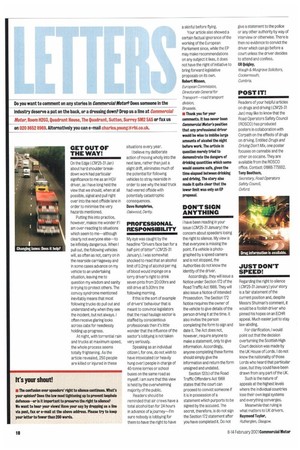GET OUT OF THE WAY!
Page 20

If you've noticed an error in this article please click here to report it so we can fix it.
On the Edge (CM25-31Jan) about hard shoulder breakdown work had particular significance to me as an HGV driver, as I have long held the view that we should, when at all possible, signal and pull right over into the next offside lane in order to minimise the very hazards mentioned.
Putting this into practice, however, makes me wonder if I am over-reacting to situations which seem to me--although clearly not everyone else--to be infinitely dangerous. When I pull out, the following vehicles will, as often as not, carry on in the nearside carriageway and in some cases advance on my vehicle to an undertaking situation, leaving me to Question my wisdom and sanity in trying to protect others. The convoy syndrome mentioned inevitably means that most following trucks do pull out and understand why when they see the incident, but not always. I often receive glaring looks across cabs for needlessly holding up progress.
At night, with torrential rain and trucks at maximum speed, the whole process seems totally frightening. As the article revealed, 250 people are killed or injured in these situations every year.
I believe my deliberate action of moving wholly into the next lane, rather thanjust a slight drift, eliminates much of the potential for following vehicles to stray nearside in order to see why the lead truck had veered offside with potentially catastrophic consequences.
Dave Humphries,
Oakwood, Derby.
































































































